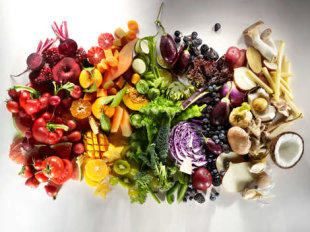To eat right without even thinking about it, fill your plate with a rainbow's worth of health-boosting, metabolism-revving nutrients. By Meghan Rabbitt, REDBOOK.
 The best superfoods
The best superfoods
1. Apples may be just as powerful as oatmeal when it comes to lowering "bad" cholesterol.
2. Snack on watermelon after a workout. It has L-citrulline, an amino acid that helps remove painful lactic acid from muscles more quickly.
3. Jazz up roasted sweet potatoes by adding chipotle powder (which has the disease-fighting compound capsaicin).
4. The most powerful immune-boosting nutrients are found in citrus peel, not the fruit itself. Zest it!
5. New research has found that kiwifruit can significantly reduce fatigue and depression.
6. Cooked tomatoes are even healthier than uncooked ones. The heat helps you absorb the antioxidant lycopene.
7. Pair leafy greens with foods rich in vitamin C and you'll better absorb their high levels of iron.
8. Research shows that eating one cup of blueberries every so often could boost abdominal fat loss by up to 77 percent.
9. Red cabbage has more vitamin A and iron than its green counterpart, and makes a great taco filling.
Sauté fresh mushrooms with rehydrated dried ones for intense flavor--and more readily absorbed nutrients.
10. For a quick boost, reach for unsweetened coconut flakes. Their healthy fats provide much of the energy for your body's cell function.
Red
The rosy hue in the luscious produce on the previous page comes from lycopene, an antioxidant that protects skin from sun damage and decreases the risk of heart disease and certain forms of cancer, says Ashley Koff, a registered dietitian in Washington, DC, and author of Mom Energy. Red fruits and veggies are also rich in anthocyanins, powerful flavonoids that fight cancer and reduce the risk of heart attack. Plus, they maintain memory function and keep the urinary tract healthy.
Blue + Purple
These dark beauties have hefty doses of phenolics and resveratrol, two plant nutrients that reduce the risk of cancer, stroke, and heart disease while they improve memory. And like produce in the red color group, blue and purple fruits and veggies get cancer-fighting powers from anthocyanins, those powerful antioxidants. "While purple veggies like cabbage and eggplant might seem daunting to work into your diet, they're a lot easier to cook than you might think, and less expensive than berries," says Largeman-Roth.
Tip: Red cabbage has more vitamin A and iron than its green counterpart, and makes a great taco filling.
Orange + Yellow
Fruits and veggies in this color family are all immune-boosting powerhouses, says Koff, thanks to their carotenoids, which are converted to vitamin A in the body. Vitamin A is just as important as vitamin C, if not more so, when it comes to building a healthy immune system. "You might not think of mango and butternut squash as foods that can prevent you from getting sick, but they are," says Frances Largeman-Roth, a dietitian and the author of Eating in Color. "Adding sunshine-colored foods to your diet also boosts reproductive health and gives you clearer skin."
Tip: Cooked tomatoes are even healthier than uncooked ones. The heat helps you absorb the antioxidant lycopene.
White + Tan
So white and tan produce count as nutritional heroes? Definitely, says Koff. "These fruits and veggies may look bland, but they've got plenty of health benefits." They're loaded with anthoxanthins, which have been shown to help lower cholesterol and blood pressure as well as prevent heart disease. Many of the foods in this color group also contain allicin, which may decrease the risk of stomach cancer and inhibit tumor growth. Largeman-Roth adds another plus when it comes to white and tan produce: "These foods have a lot of texture going on," she says, "which makes them interesting to cook and eat."
Green
Doctors and dietitians agree that if you're looking to lose weight, you should load up on greens. "That's because every vegetable in the green spectrum is low in calories and high in fiber," says Largeman-Roth. "You get a lot of nutrition in a low-cal package that'll fill you up." The chlorophyll in greens may help ward off cancer and has alkalizing benefits, helping to bring the body back to a healthy pH balance. (Most of us are acidic, thanks to the processed foods we eat.) Green foods also have high levels of certain phytochemicals that help break down carcinogens and strengthen bones and teeth, says Koff.
Tip: Pair leafy greens with foods rich in vitamin C and you'll better absorb their high levels of iron.
From Redbook - http://www.redbookmag.com/health-wellness/advice/the-healthiest-superfoods






